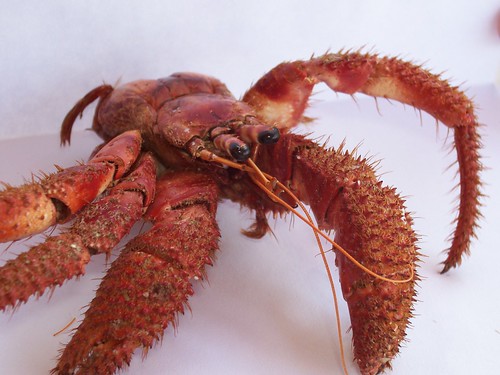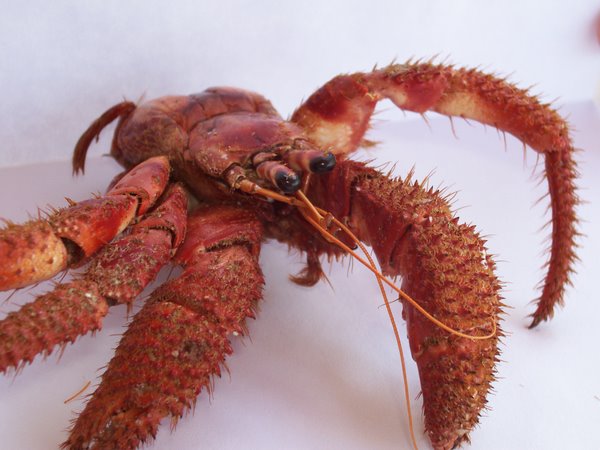dictionary-schmictionary: Λεξικό να σου πετύχει - 4 από 4
Σήμερα τελειώνουμε την ενασχόλησή μας με το λεξικό επιστήμης και τεχνολογίας τροφίμων, πόνημα πανεπιστημιακού δασκάλου.
Χώματα και Συκώτια
Χώματα και Συκώτια

Σχόλιο για το λήμμα 1653:
H χωματίδα που αναφέρει ο συγγραφέας είναι ψάρι! Θα το βρείτε και χαματίδα, χρωματίδα ή γλωσσάκι και αναφέρεται κυρίως στα ψάρια των ειδών Platichthys flesus, Pleuronectes platessa και Hippoglossoides platessoides. Ο αγγλικός όρος little bustard αναφέρεται στη χαμωτίδα η οποία είναι πουλάκι και όχι ψαράκι – τατάα… Ορίστε και μία σελίδα με φωτογραφίες τού εν λόγω πτηνού από το Google.Σχόλιο για το λήμμα 1657:
Eνδιαφέρουσα ακυρολογία (malapropism, αν προτιμάτε). Ο συγγραφέας θα έπρεπε να γράψει livestock (‘ζώα εκτροφής’) αντί του ανύπαρκτου liverstock (sic) που παραπέμπει σε εκτροφή συκωτιού ή συκωτο-αποθέματα.
Το οκτωλεωφορείο - ή (ο)χταλεωφορείο επί το λαϊκώτερον
Ο λαδοκόκορας

Για το λήμμα 2321, υπενθυμίζουμε στον κ. καθηγητή ότι το χταπόδι λέγεται octopus (ετυμολογούμενο από τις λέξεις οκτώ και πους, ‘πόδι’) και όχι octobus(sic) (ετυμολογούμενο άραγε από τις λέξεις οκτώ και λεωφορείο –bus στα αγγλικά).
Το σχόλιό μας για το λήμμα 2331: εδώ έχουν ξεπεραστεί τα όρια της άγνοιας και του φαιδρού, και είμαστε πλέον στα όρια της άνοιας και μωρίας. Old rooster είναι ο γερο-πετεινός, Oil rooster(sic) είναι ο λαδοκόκορας και σίγουρα δεν είναι η «μεγάλη σε ηλικία κότα» όπως ισχυρίζεται ο κ. καθηγητής.
Μία τετράδα
Συνοπτικά σχόλια στα τέσσερα σημειωμένα αποσπάσματα:
1.
Το Quark (προφορά κβαρκ) είναι γερμανικό τυρί, αυτό που οι Βαυαροί και Αυστριακοί αποκαλούν Topfen. Το αντίστοιχο στα γαλλικά θα ήταν fromage frais ή caillé.
2.
Η quenelle δεν είναι πουτίγκα, μια και εμείς οι Έλληνες έχουμε ταυτίσει την πουτίγκα με ένα επιδόρπιο με βάση το ψωμί (τουλάχιστο σύμφωνα με τη βρετανική παράδοση). Θα ήταν πολύ καλύτερο αν ο συγγραφέας απέδιδε τον όρο ως «είδος σπιτικού ζυμαρικού» και ακολουθούσε τη συλλογιστική του όρου dumpling.
3.
Η εν λόγω αλμυρή τάρτα είναι το γνωστό quiche. Ο όρος quinhe(sic) είναι ανύπαρκτος και παραπέμπει στις αγγλικές λέξεις quince ‘κυδώνι’, quinine ‘κινίνο’ και quinoa ‘κινόα, σπόροι ενός Περουβιανού φυτού’
4.
Ίσως θα πρέπει να χρησιμοποιήσουμε τον όρο quintessence (‘πεμπτουσία’) και τον ορισμό του συγγραφέα («το εξαίρετο ενός πιάτου») για να εξάρουμε και τη συνεισφορά του συγγραφέα στη μαγειρική βιβλιογραφία. Ένιγουεϊ…
Το σκουληκόψωμο
Στο λήμμα 1594 βλέπετε ότι, σύμφωνα με τον πανεπιστημιακό καθηγητή, το «σκεύασμα από φύκια» στα αγγλικά λέγεται larva (sic) bread. Εμείς, διορθώνοντάς τον, σας λέμε ότι το «σκεύασμα από φύκια» λέγεται laver bread, ή bara lawr στα ουαλικά. Laver είναι ένα φύκι της οικογένειας Porphyra – ορίστε και η σχετική σελίδα από την αγγλική Wikipedia, η οποία, παρεμπιπτόντως, μάς πληροφορεί ότι στην οικογένεια Porphyra ανήκει και ένα είδος από το γιαπωνέζικο nori, λέξη γνωστή σε αρκετούς καταναλωτές σούσι. Larva, τώρα, ονομάζεται η προνύμφη ενός εντόμου, στάδιο στη μεταμόρφωσή τους: έμβρυο-προνύμφη-νύμφη (ή χρυσαλλίδα)-ενήλικο έντομο. Αν και τα έντομα αποτελούν bona fide βρώσιμα συστατικά σε αρκετές κουζίνες του κόσμου (όπως της επαρχίας Oaxaca στο Μεξικό, λ.χ.), είναι λίγο δύσκολο να αποτελέσουν υλικό σε ένα κελτικό ψωμί. Οπότε, σπεύδουμε να διορθώσουμε τον κ. καθηγητή και να του πούμε ότι το σωστό είναι: «laver bread: σκεύασμα από φύκια (Ουαλία)». Το κωμικό είναι ότι αμέσως παρακάτω (στο λήμμα 1595) ο συγγραφέας αναφέρει το λήμμα larvae ως «νύμφη»(sic), διαπράττοντας ένα ακόμα λάθος, καθώς η νύμφη ενός εντόμου στα αγγλικά λέγεται pupa. Ακόμη πιο κωμικό είναι το ότι, στο λήμμα 1601 (βλέπε φωτογραφία αμέσως παρακάτω) ο συγγραφέας αναφέρει το λήμμα laver και ο ερμηνεύει ως «είδος φυκιού»! Όμως, η μηδενική γλωσσική επιμέλεια στο εν λόγω λεξικό δεν επέτρεψε σε κανένα να δει ότι σύμφωνα με (ακόμα και με τα κακά, στρεβλά και ανάποδα) τα ίδια τα γραφόμενα του συγγραφέα, έντομα (και όχι φύκια, όπως είναι το σωστό) εμφανίζονται ως υλικά σε ουαλικό ψωμί.
Στην περίπτωσή μας θα ταίριαζε γάντι και η ουαλική παροιμία “Llygad cywraint yn mhen anghywraint”, μεταφραζόμενη στα αγγλικά 'Keen eyes are small gain in a head without brain'
Εδώ τελειώνουμε την ενασχόλησή μας με το εν λόγω λεξικό επιστήμης και τεχνολογίας τροφίμων. Μην ανησυχείτε, όμως, έχουμε αφήσει περισσότερα από 70 λάθη μικρότερα ή και μεγαλύτερα από αυτά που καλύψαμε στα τέσσερα τελευταία post. Σας συμβουλεύουμε να μείνετε αλάργα από το λεξικό αυτό αν τύχει και το συναντήσετε στο δρόμο σας. Έχετε καλύτερα πράγματα να κάνετε με τα χρήματά σας από το να τα δώσετε για την αγορά του πονήματος τού πανεπιστημιακού δασκάλου.
.
.
.
Το Quark (προφορά κβαρκ) είναι γερμανικό τυρί, αυτό που οι Βαυαροί και Αυστριακοί αποκαλούν Topfen. Το αντίστοιχο στα γαλλικά θα ήταν fromage frais ή caillé.
2.
Η quenelle δεν είναι πουτίγκα, μια και εμείς οι Έλληνες έχουμε ταυτίσει την πουτίγκα με ένα επιδόρπιο με βάση το ψωμί (τουλάχιστο σύμφωνα με τη βρετανική παράδοση). Θα ήταν πολύ καλύτερο αν ο συγγραφέας απέδιδε τον όρο ως «είδος σπιτικού ζυμαρικού» και ακολουθούσε τη συλλογιστική του όρου dumpling.
3.
Η εν λόγω αλμυρή τάρτα είναι το γνωστό quiche. Ο όρος quinhe(sic) είναι ανύπαρκτος και παραπέμπει στις αγγλικές λέξεις quince ‘κυδώνι’, quinine ‘κινίνο’ και quinoa ‘κινόα, σπόροι ενός Περουβιανού φυτού’
4.
Ίσως θα πρέπει να χρησιμοποιήσουμε τον όρο quintessence (‘πεμπτουσία’) και τον ορισμό του συγγραφέα («το εξαίρετο ενός πιάτου») για να εξάρουμε και τη συνεισφορά του συγγραφέα στη μαγειρική βιβλιογραφία. Ένιγουεϊ…
Το σκουληκόψωμο
Στο λήμμα 1594 βλέπετε ότι, σύμφωνα με τον πανεπιστημιακό καθηγητή, το «σκεύασμα από φύκια» στα αγγλικά λέγεται larva (sic) bread. Εμείς, διορθώνοντάς τον, σας λέμε ότι το «σκεύασμα από φύκια» λέγεται laver bread, ή bara lawr στα ουαλικά. Laver είναι ένα φύκι της οικογένειας Porphyra – ορίστε και η σχετική σελίδα από την αγγλική Wikipedia, η οποία, παρεμπιπτόντως, μάς πληροφορεί ότι στην οικογένεια Porphyra ανήκει και ένα είδος από το γιαπωνέζικο nori, λέξη γνωστή σε αρκετούς καταναλωτές σούσι. Larva, τώρα, ονομάζεται η προνύμφη ενός εντόμου, στάδιο στη μεταμόρφωσή τους: έμβρυο-προνύμφη-νύμφη (ή χρυσαλλίδα)-ενήλικο έντομο. Αν και τα έντομα αποτελούν bona fide βρώσιμα συστατικά σε αρκετές κουζίνες του κόσμου (όπως της επαρχίας Oaxaca στο Μεξικό, λ.χ.), είναι λίγο δύσκολο να αποτελέσουν υλικό σε ένα κελτικό ψωμί. Οπότε, σπεύδουμε να διορθώσουμε τον κ. καθηγητή και να του πούμε ότι το σωστό είναι: «laver bread: σκεύασμα από φύκια (Ουαλία)». Το κωμικό είναι ότι αμέσως παρακάτω (στο λήμμα 1595) ο συγγραφέας αναφέρει το λήμμα larvae ως «νύμφη»(sic), διαπράττοντας ένα ακόμα λάθος, καθώς η νύμφη ενός εντόμου στα αγγλικά λέγεται pupa. Ακόμη πιο κωμικό είναι το ότι, στο λήμμα 1601 (βλέπε φωτογραφία αμέσως παρακάτω) ο συγγραφέας αναφέρει το λήμμα laver και ο ερμηνεύει ως «είδος φυκιού»! Όμως, η μηδενική γλωσσική επιμέλεια στο εν λόγω λεξικό δεν επέτρεψε σε κανένα να δει ότι σύμφωνα με (ακόμα και με τα κακά, στρεβλά και ανάποδα) τα ίδια τα γραφόμενα του συγγραφέα, έντομα (και όχι φύκια, όπως είναι το σωστό) εμφανίζονται ως υλικά σε ουαλικό ψωμί.
Στην περίπτωσή μας θα ταίριαζε γάντι και η ουαλική παροιμία “Llygad cywraint yn mhen anghywraint”, μεταφραζόμενη στα αγγλικά 'Keen eyes are small gain in a head without brain'
Εδώ τελειώνουμε την ενασχόλησή μας με το εν λόγω λεξικό επιστήμης και τεχνολογίας τροφίμων. Μην ανησυχείτε, όμως, έχουμε αφήσει περισσότερα από 70 λάθη μικρότερα ή και μεγαλύτερα από αυτά που καλύψαμε στα τέσσερα τελευταία post. Σας συμβουλεύουμε να μείνετε αλάργα από το λεξικό αυτό αν τύχει και το συναντήσετε στο δρόμο σας. Έχετε καλύτερα πράγματα να κάνετε με τα χρήματά σας από το να τα δώσετε για την αγορά του πονήματος τού πανεπιστημιακού δασκάλου.
.
.
.







5 comments:
Congratulations on such a funny blog. I speak Greek but I am not a very good writer, yet. Just to be sure, these mistakes were found in culinary lexicon?
They were found in an English-Greek dictionary of food science and technology. Looks like many of the English terms were "all Greek to" the writer, a university teacher at that.
Wow... Dictionary Schmictionary is right!!!
I"m wondering if you could clear up something regarding beef. What is moschari and bodino in English? (sounds simple I know but sometimes this question opens up a big can of worms!) Also, could the word arni be used interchangebly with lamb and mutton, or is it stricly lamb?
Thanks!
Can of worms, indeed: bovines are tricky business. So, let’s make a developmental arrangement:
Mosxari galaktos: up to 6 months old, 150 kgs max (+dentition requirements). Could be translated as veal.
Mosxari: animal aged up to 30 months (+dentition requiremets). Could be translated as calf.
Bodino: older than the previous (+ dentition requirements). Could be translated as beef.
We manipulate the animals to suit our purposes and our consumer whims (“animal husbandry” is the term). Castration is a millennia-old technique that springs to mind, though we have managed to “sterilise” the term by referring to the said animal as “steer” or “bullock”.
The dentition requirements are mentioned because the vets who inspect the animals at the slaughterhouses (and have readier access to the animals’ teeth than us) stamp the carcasses accordingly.
Arni is the generic term used for the animal.
Arnaki galaktos is the sucking lamb (or suckling lamb, depending on your degree of tolerance of linguistic ‘purity’), 30-45 days old, with weight depending on the race of the animal. By the book now, you could call “arni” the animal up to the age of 4 months and up to the loss of the first median incisors (here’re the dentition requirements again). After the end of the fourth month (and the loss of some other incisors), it is called provato (mutton).
Be advised that ALL ages mentioned above are according to the Greek Food Code. That’s why, earlier, I mentioned that they COULD be translated as such-and-such.Different countries follow radically different standards, many of which spring from local consumer preference. (Case in point: Greek consumers don’t want to be told they are eating bodino – they prefer the term “mosxari”, so this automatically messes up the correspondence of the Greek with the American and British term “beef”). Also be advised that local Greek populations with a long pastoral tradition have their own preferences (and strife) regarding the best races of lambs for milk or for meat, as well as their own charming, yet esoteric, nomenclature (may I just interject the term βεργάδι here, which in some parts of Greece signifies the young billygoat). I suspect the same happens in Wales, a land with a long sheep-pastoral tradition.
There is no simple answer to your question: even a cursory look under the entries “beef”, “lamb” and “pork” in Larousse Gastronomique will show you that there are at least 3 different schools in the sectioning of the carcasses: British, American, French. So, once you start cutting up the carcass, many new words pop up, with precious few one-on-one correspondences.
Ahhh okay...Although I think perhaps something has changed in the mind of the Greek consumer in the last year. Apart from butcher shops, I've noticed that a few of the supermarkets have started stocking alot more bodino than before. Especially AB. I was there last week and the counter had quite a variety of different cuts of beef (bodino). Last year, I happened to find some beef brisket at AB and they were practically giving it away at (3euro/kilo). This year, 7 euro the kilo. I swear, if this fashion to revisit peasant dishes continues, I wont be left with any tricks up my sleave!!
Post a Comment